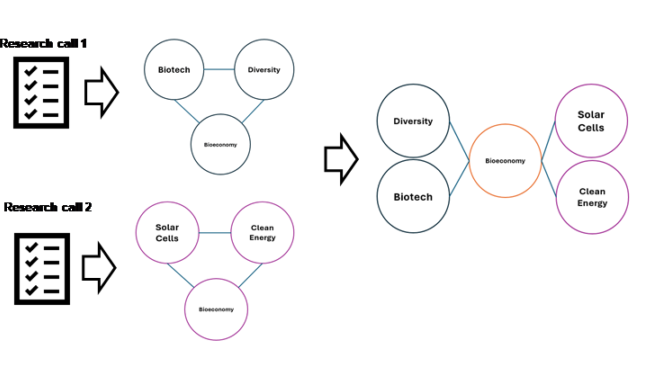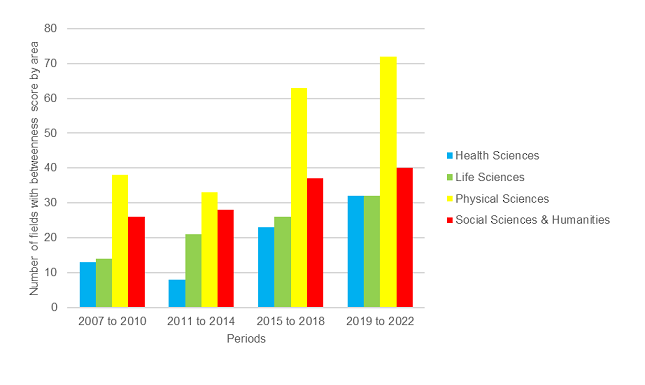The changing tunes of science policy: mapping research priorities of consecutive governments
When governments change, science policy can be affected as well. This blog post discusses a method to track these shifts using the example of Colombia. Results show that over time, the number and connectedness of research fields in science policy increases, but only a few survive all governments.
Imagine national science policy as a musical chair game. The contestants are the science system actors, such as researchers, research groups, universities, companies, among others. Some actors can have more expertise dancing at the rhythm of salsa than hip-hop, while others might be more agile in finding a seat when the music pauses. The government plays or pauses the music, modulates its speed or changes the genre. The hint is that the atmosphere of the game changes when there is a change of government: a government might play more salsa than hip-hop or pause the music more often, giving an edge to some actors over others.
This is a common scenario in liberal democracies where citizens vote for government candidates each 4 to 6 years. Since each government might enforce policies according to a party’s ideology or program, it might also bring a novel vision and priorities for science policy to the table. Furthermore, in 2024, around half of the world population will vote in elections. It seems crucial to contrast this historical moment with insights on how changes in governments affect science policy priorities and how this can be mapped and analysed.
In a recent study published in Quantitative Science Studies, we analysed how science policy changed priorities in Colombia from 2007 to 2022. We sourced the strategic fields prioritized in science policy during this period. Public funding and research-oriented calls are administered by Colciencias — now the Ministry of Science, Technology and Innovation. This was our main material to identify strategic fields prioritized by each government in office. We found that the number of strategic fields is getting larger and more interconnected as time passes. Despite this complexity, just a few fields maintained their higher strategic relevance, regardless of the government in office.
Science PolicyScience policy can be defined as a set of processes that affect how the rules and practices to develop basic or applied research are designed and implemented within national borders for private and public actors. It also gives shape and direction of knowledge production to actors in the science system. |
Science policy as a network
Government research calls are a key strategy for science policies. Using co-word analysis, we built the internal structure of research calls, therefore science policy priorities. Co-word analysis enables to visualize the structure of concepts in relation to others.
For instance, imagine that a given government —in its science policy vision— wants to support research on biotechnology applied to biodiversity, all of that under the purpose of building up bioeconomy capacities in research centres. We will name this Research call 1. In a different call, let's call it Research call 2, the government supports basic research on clean energy, particularly solar cells, to strengthen capacities in knowledge-intensive firms in the bioeconomy sector.
In the scenario of Research call 1, biotechnology, diversity and bioeconomy are related via their simultaneous inclusion in Research call 1. Therefore, each term can now be transformed into a circle (node) connected with a line (link) to the other term, forming a network. The same happens for Research call 2.
Even more interestingly, we can see that Research calls 1 & 2 have a term in common in their agenda: bioeconomy. Therefore, bioeconomy serves as an intermediary between Research call 1 & 2. In other words, bioeconomy is a term with relatively high betweenness centrality. Betweenness centrality quantifies the importance of a node in a network based on how often it lies on the shortest paths connecting other nodes (i.e., fields). It acts like a gatekeeper and enables or disables the flow of information between different segments of a network.
In our context, a research field with higher betweenness centrality, such as bioeconomy in Research calls 1 & 2, facilitates the connection between distinct research areas. As we might suspect, some research fields will reach a higher betweenness centrality score than others.
This procedure enabled us to determine each government’s science policy priority by grouping each administration's research calls, identifying the strategic research fields mentioned and mapping the connections between them. We can apply this technique to research calls with many research fields or the aggregated set of research calls by a government. We show this procedure in the figure below (Figure 1).
To standardize research fields, we used the All Science Journal Classification standard. This standard is a Scopus in-house service used by experts when a serial title is set up for Scopus coverage by classifying the title in a subject and area, based on the aims and scope of the title and on the content it publishes. This standard groups science subjects into four areas (physical sciences, health sciences, social sciences, and life sciences) and 333 fields.

Unveiling changing science policy priorities
We analysed the structure of 389 research calls issued by Colciencias (now the Ministry of Science, Technology and Innovation, Colombia) between 2007 and 2022. During this period, there were four governments in office, with terms of four years each. We analysed the set of calls of each government. Figure 2 below shows the periods of each government and the numbers of fields with betweenness score per area. The areas with the most fields with betweenness centrality score were physical sciences and social sciences and humanities, followed by life sciences and health sciences.
It is worth noting that not every field has a betweenness centrality score. Although a field can appear in the science policy vision of a government, this does not mean that it has a gatekeeper role amidst the flow of information between different segments of a network. It can be a peripheral field with a single link to another peripheral field with no particular strategic position.

Short vs. long term priorities
When we looked at the betweenness score changes for those fields identified throughout 2007-2022, we saw that out of 333 fields, 248 were mentioned at least once in all four periods. However, when we selected those with above median betweenness score, the sub-sample was reduced to only 14. These are the fields with sustained relevance for all governments and high strategic value as defined by their betweenness score. Interestingly, health sciences were absent from this list. The figure below shows the changing, although consistent, betweenness score of those 14 strategic fields (Figure 3).


When we reduce the list to the top-five most highly strategic fields —or those fields with the top-five highest betweenness centrality score—for all governments between 2007-2022, this results in the following research fields:

What could explain our results?
In Colombia, 2015 marked a year of significant research and development investment, reaching 0.37% of the gross domestic product, the highest since 1996. This substantial budget likely empowered policy-making actors, granting them greater influence. Additionally, the expansion of scientific output and interdisciplinary connections could account for the observed interconnected fields between 2015-2018 and 2019-2022. Furthermore, our findings align with a general trend of transition from science policy government to governance, emphasizing the involvement of a broader range of stakeholders in shaping research objectives both within and beyond the scientific ecosystem. This shift acknowledges that science policy priorities may evolve with changes in government and/or the formation of political coalitions.
What do we learn from this?
Just like governments change, so do their strategic research priorities. This research helps us understand these shifts and identify the medium-long term research fields prioritized in the underlying dynamic of science policy and its governance. Science policy acts as a rulebook for how governments, universities, and companies conduct research within a country. Ideally, these policies would have a long-term vision, but developing nations like Colombia often struggle with this (more here and here).
The research presented here offers a way to understand how policy changes impact research focus and provides policymakers with tools to strategically allocate funding. To come back to our analogy from the beginning of the post, our approach shows how to visualize the music score currently being played in the science policy-musical chair game and what have been the most played genres and how pauses might produce a change in this. As a result, we, the science policy players, can learn to dance salsa rather than hip-hop and be more attentive to the position of the chair so as to keep on playing the game.
Header image: Ardian Lumi on Unsplash
Doi: 10.59350/6zjf4-wyd11 (export/download/cite this blog post)




0 Comments
Add a comment